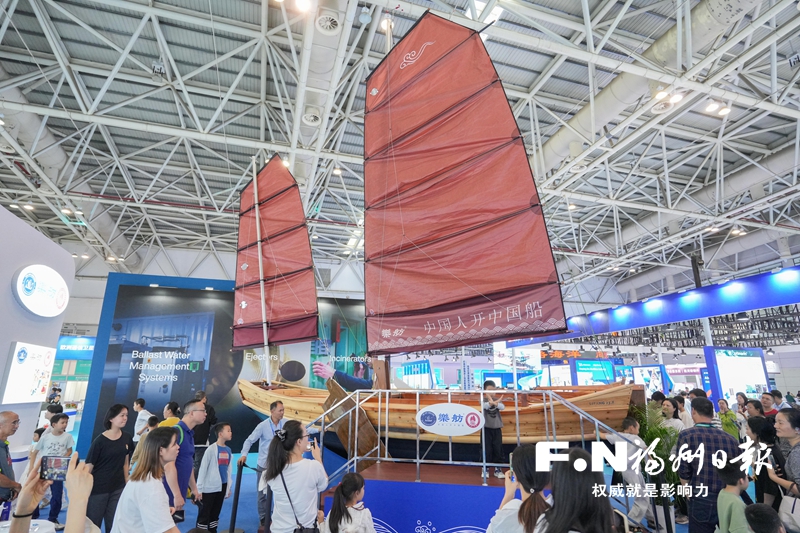As the hull is assembled, the freestanding mast raised, and the red Chinese soft wing sail hoisted, a wooden Chinese sailboat stands out amid the futuristic exhibits at the Second China Maritime Equipment Expo 2024. The striking characters on the red sail reading “Chinese People Sail Chinese Boats” catch the eyes of visitors. Many pause to take photos for memory, while curious enterprises approach to inquire about details.
“This is the world’s first wooden sports-style Chinese sailboat to receive international certification - ‘Le Fang 23.8,’” said its designer, Kuang Xiangrong. The vessel meets the European Union’s CE certification C-level stability standards, ensuring safe navigation in sea conditions with winds up to Force 6 and significant wave heights of up to 2 meters.
In a conversation with Kuang Xiangrong, the reporter could sense his unyielding determination and deep emotional bond with Chinese sailboats.

The “Le Fang” Sailboat Draws Crowds of Admirers.Reporter: Bao Hua / Photography
Amid “Rivalries”
Falling for Chinese Sailboats
Seventy-year-old Kuang Xiangrong, born in Hong Kong, is a Fellow of the Royal Institute of British Architects, President of the Maritime Culture Association of China (Macao), and is hailed as the “Father of Modern Chinese Sailboats”. He is a devoted guardian of Chinese sailboats.
Why has Kuang Xiangrong who was so experienced with Western sailboats become so fascinated by Chinese sailboats? He explains that his passion began with a series of “rivalries” involving Chinese sailboats.
“More than 30 years ago, I was sailing a fiberglass Western sailboat when I encountered a Chinese sailboat from the mainland passing through HK Victoria Harbour,” Kuang recalls. At the time, sailboats from the mainland were wooden, with worn-out hulls and patched sails. A sudden idea struck him: Why not see whose boat is faster?
The race had barely started when Kuang Xiangrong was taken aback by the performance of the Chinese sailboat. “When the wind was strong, our boat sailed better. But when the wind dropped, the semi-rigid sails of the sailboat proved far more efficient, effortlessly overtaking us,” he recounted.
Kuang Xiangrong’s interest in sailing began during his university years when he and his classmates purchased their first small Western sailboat. After graduating, he joined the Royal Hong Kong Yacht Club and teamed up with senior classmates from the architecture department to form an all-Chinese crew for sailing competitions. Competing against predominantly Western sailors, they stood out and won second place, an achievement that filled him with pride.
From that point on, he became an enthusiastic participant in one-design class sailing races. “My dream is to sail around the world in a Chinese sailboat I’ve built myself, bringing the culture of Chinese sailboats to every sea,” Kuang Xiangrong said.
Inspired by the Fujian Boats
Designing the Modern Chinese Sailboat
To design a sailboat most suitable for safe circumnavigation, Kuang Xiangrong traveled across China to explore the shapes of traditional Chinese sailboats and learn about shipbuilding techniques. He analyzed the structure of wooden Chinese sailboats from the perspective of an architect, diligently studying ship design software. Using computer modeling, he calculated the stability and sailing resistance of the boat, continuously simulating how the vessel would perform in various wind and wave conditions. However, he was never satisfied with the designs of traditional fishing boats.
By chance, Kuang Xiangrong visited Quanzhou, where he discovered the unique “sharp-bottom” line shape of a South Song Dynasty ancient ship unearthed from Quanzhou Bay. After several computer simulations, the results confirmed that this shape could enhance the stability of the ship. The sharp-bottomed hull demonstrated exceptional resistance to leeway when sailing into or across the wind. This discovery also supported the description of ancient sailboats in the Illustrated Accounts of the Imperial Mission to Korea in the Xuanhe Period from the Song Dynasty, which described ancient sailing ships as “flat on top like a balance beam, sharp on the bottom like a blade, prized for their ability to cut through waves”. Based on the sharp-bottom shape of the South Song ship, he designed the world’s first modern Chinese sailboat.
“Chinese sailboats are an important symbol of Chinese maritime culture,” Kuang Xiangrong said. With technological advances, diesel engines gradually replaced wind power, and the craftsmanship of Chinese ships has been passed down mostly through oral tradition, with few professional books documenting techniques for building and sailing sailboats. He realized that traditional Chinese boat culture was slowly fading away.
In addition to his independent research, he also worked with a group of middle school students to experience sailing the Chinese sailboat. “I hope the seeds of Chinese sailboats can be planted in the hearts of children, fostering national confidence”, he said.
When it comes to Chinese sailboats, Kuang Xiangrong spoke with pride. “Chinese sailboats have many advantages in performance, but what I value most is the cultural significance they embody.” In his designs, every Chinese sailboat has prominent words on its sail: “Chinese people sail Chinese boats.”
Participating in the Maritime Equipment Expo
Promoting Chinese Boat and Ship Culture
The slogan “Chinese people sail Chinese boats” confidently set sail and entered the scene of this year’s Maritime Equipment Expo. To prepare for the exhibition, Kuang Xiangrong and his partners were busy setting up and assembling the “Le Fang 23.8” piece by piece, much like building with blocks.
Upon closer inspection of the sailboat, one can easily spot the craftsmanship and attention to detail: materials are sourced locally, and different types of wood are used according to their characteristics. The framework is made from lychee wood and white eucalyptus; the curved grains of the lychee wood are perfect for the ribs, while the white eucalyptus prevents marine pests. The hull is constructed with light, tough cedar wood, and the interior is adorned with sturdy yet aesthetic ailanthus altissima swingle wood featuring exquisite textures.
“This boat is not just my work alone; a 73-year-old master and two masters in their 50s, along with inheritors of the Fuchuan boat-making tradition, helped me bring this boat from design to reality in July this year,” said Kuang Xiangrong. These three masters are inheritors of the Fujian boat-making technique from the Ningde Jiaocheng District Watertight Compartment Fu Ship Research Association. Eight years ago, Kuang and the association bonded over their shared love of Chinese sailboats and have since worked together to promote the Fujian boat culture.
At the expo, many visitors gained a deeper understanding of Chinese sailboats through Kuang’s introduction. “The performance of the Chinese sailboat is so excellent; it’s truly amazing,” said Mr. Lin, an enthusiast of Western yachts, who has sailed to places like the Philippines and Australia. After hearing Kuang Xiangrong’s introduction, he was deeply impressed. “I hope I can have the chance to sail on a Chinese sailboat and experience the unique charm of Chinese traditional culture.”
“The history of Chinese wooden sailboats is long and rich, and they are a testament to our maritime power. But this culture might disappear in our generation. I hope to contribute to promoting Chinese boat and ship culture and maritime heritage, opening the door for wooden Chinese sailboats in the sports market, and ensuring that Chinese wooden sailboat culture is passed on,” said Kuang Xiangrong, still speaking with unyielding determination about the purpose of his participation in the expo. (Fuzhou Daily Reporter: Chen Junyi / Text)







